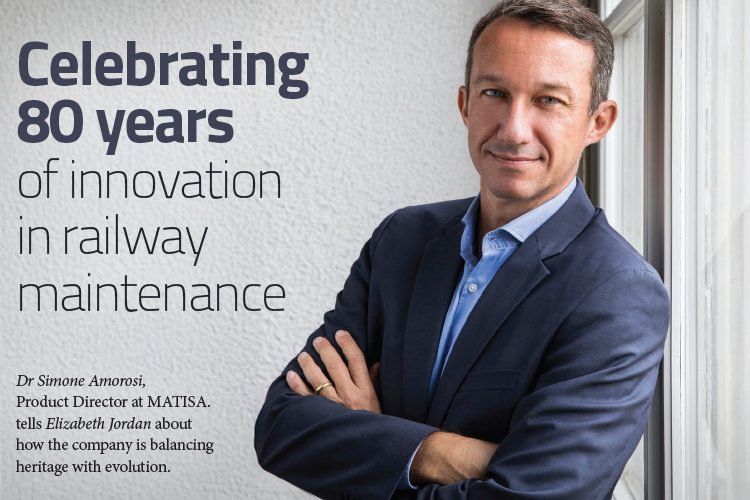Interview Spotlight: MATISA on 80 years of innovation in railway maintenance
Posted: 1 May 2025 | Dr Simone Amorosi, Elizabeth Jordan - Global Railway Review | No comments yet
As MATISA marks its 80th anniversary in 2025, the company reflects on its proud heritage while driving the future of railway infrastructure forward. In this exclusive interview, Dr. Simone Amorosi, Product Director at MATISA, speaks with Elizabeth Jordan from Global Railway Review about how the company balances legacy with innovation, embracing digitalisation, sustainability, and intelligent design to meet the challenges of a rapidly evolving rail industry.


MATISA is celebrating 80 years in 2025. How has the company balanced tradition with transformation?
Our 80th anniversary is more than a milestone, it’s a symbol of resilience and evolution. Since 1945, MATISA has continuously adapted to the changing needs of rail operators worldwide. Our legacy is rooted in Swiss engineering precision, reliability and field‑proven performance. Yet, our mindset is future-oriented. We are embracing digitalisation, automation and sustainability while preserving our fundamental values: performance, simplicity and customer focus. From mechanisation to data-driven operations, MATISA has grown from a trusted supplier into a solution partner for railway infrastructure.
What are the most pressing challenges facing rail infrastructure today and how is MATISA addressing them?
The rail industry today faces a convergence of systemic challenges: cost pressures, increasingly complex standards, climate imperatives and skilled labour shortages. MATISA responds to these with a multidimensional approach. We simplify operations through user-friendly interfaces and automation, reduce carbon impact via energy-optimised architecture and standardise our machine platforms to streamline homologation. The goal is clear: to deliver machines that are easier to operate, easier to maintain and capable of delivering more value with fewer resources.
Why are you the global leader in renewal trains?
MATISA has established itself as the global leader in renewal trains through decades of innovation, reliability and in-depth field experience. Our flagship solutions, the P 95 renewal trains and the C 75 ballast cleaners, are recognised worldwide for their performance and adaptability. We offer a unique combination of high productivity, modularity and compliance with the latest standards. Our machines are not only technically advanced but also designed to be simple to operate and maintain. This balance of innovation and usability, backed by decades of expertise in track renewal, is what makes MATISA a trusted partner for infrastructure managers across the globe.
“Our vision is anchored in three principles: simplicity, reliability and innovation.
The B 66 UC NEO Active is getting attention across Europe. What sets this machine apart in the market?
The B 66 UC NEO Active (NEO means for New Energy Optimization) is our flagship tamping solution. It represents a new generation of highefficiency, smart tamping machines. Designed for optimal energy use, the machine incorporates a dual-head tamping system, elliptical tamping technology and an integrated dynamic track stabiliser. These features not only enhance the quality of tamping but also reduce the need for repeat interventions. The result: better track geometry, longer-lasting results and a compelling return on investment for infrastructure managers.
How does MATISA integrate sustainability into the design and operation of its machines?
Sustainability is not an add-on; it’s a design principle at MATISA. We integrate optimised diesel powertrains to reduce emissions, and our machines are lighter and more compact than those of competitors, leading to lower energy consumption. We also focus on recycling systems, predictive maintenance to extend machine life and digital tools to minimise unnecessary interventions. For us, sustainability means not only reducing carbon footprint, but also extending asset life and optimising total cost of ownership.
“We integrate optimised diesel powertrains to reduce emissions, and our machines are lighter and more compact than those of competitors.”
Can you explain how automation and digitalisation are reshaping MATISA’s product strategy?
Digitalisation and automation are transformative forces, and at MATISA, we embrace them with a human-centred philosophy. Our aim is not to replace the operator, but to empower them. We are simplifying machine operation via intelligent control systems, semi-automated clamp handling and automated gantry-crane systems. Diagnostic tools and remote monitoring enable faster service and lower downtime. By embedding intelligence in the machine, we are making advanced technology accessible even to generalist operators, helping clients manage the skills gap across the industry.
How do your long-term services – like LCM and predictive maintenance – create value for your clients?
At MATISA, we view the product not just as a machine, but as a service platform. Our LCM (Life Cycle Management) model includes ECM‑compliant maintenance, retrofitting capabilities and digital diagnostics. Through predictive analytics, we help clients anticipate maintenance needs, reduce unplanned downtime and optimise spare parts use. This maximises fleet availability while lowering total cost of ownership. We also offer continuous training and upgrade paths, ensuring that machines evolve with customer requirements over decades.
What role does R&D play in MATISA’s strategy?
R&D is a cornerstone of MATISA’s long-term competitiveness. We invest continuously in innovation, mechanical, digital and procedural. Many of our innovations are protected by patents. These innovations accelerate our capacity to test, validate and iterate. Beyond product features, R&D at MATISA supports new business models too, such as modular retrofitting and data-driven maintenance contracts.
Looking ahead, what is your vision for MATISA over the next decade in the context of a rapidly evolving rail industry?
We see MATISA evolving into a global enabler of intelligent, sustainable infrastructure renewal. Our vision is anchored in three principles: simplicity, reliability and innovation. We will continue to lead the market in track renewal and maintenance, but with a sharper focus on digital integration, energy efficiency and lifecycle optimisation. Whether through smarter tamping, rail-only renewal, or embedded systems, our goal is to support infrastructure managers in doing more with less; more performance, more availability, less impact. We don’t just build machines. We build trust through intelligent engineering.
The TRR is your latest rail-only renewal solution. What makes this innovation so important today?
The TRR (Train de Renouvellement des Rails) reflects a strategic shift in infrastructure renewal. Today, concrete sleepers often last more than 50 years, while rails typically require replacement after 20 to 25 years. Full track renewal is no longer always justified, technically, economically or environmentally. The TRR enables high‑speed, rail-only renewal while preserving the sleepers. A key feature is our advanced rail-heating system, which uses a combination of electromagnetic induction and infrared to safely neutralise rail stress during installation. This ensures precise tensioning and immediate reopening of the line at nominal speed. For infrastructure managers facing tighter access windows and sustainability targets, the TRR offers a smarter, lower-impact solution.
How does MATISA ensure its machines meet the diverse regulatory and operational needs of different countries?
Our approach is based on modularity and adaptability. Every MATISA machine is designed on a standardised platform, which we then customise based on the specific requirements of each country, whether it’s track gauge, safety regulations or environmental standards. We work closely with certification bodies to ensure fast and smooth homologation. This allows us to deliver machines that are both compliant and operationally optimised for local conditions, without compromising on lead times or product quality.
What role does human-centred design play in MATISA’s innovation strategy?
While technology is at the heart of our machines, usability is equally critical. Our philosophy is that innovation must serve the people who operate and maintain the equipment. That’s why we focus on ergonomic cabins, simplified control systems, intuitive interfaces and reduced physical workload. Whether it is a tamping-machine operator or a maintenance technician, every user benefits from a design that prioritises clarity, safety and efficiency. This user-centric approach also facilitates faster training and helps address the growing skills gap in the railway workforce.
MATISA’s commitment to intelligent engineering and customer-focused innovation shines through as it celebrates 80 years of excellence. From pioneering track renewal technologies to integrating sustainability and digitalisation, MATISA continues to shape the future of railway maintenance worldwide.
Don’t miss the full Spring/Summer 2025 issue of Global Railway Review, proudly supported by MATISA, available now!
Global Railway Review Autumn/ Winter Issue 2025
Welcome to 2025’s Autumn/ Winter issue of Global Railway Review!
The dynamism of our sector has never been more apparent, driven by technological leaps, evolving societal demands, and an urgent global imperative for sustainable solutions.
>>> Read the issue in full now! <<<



